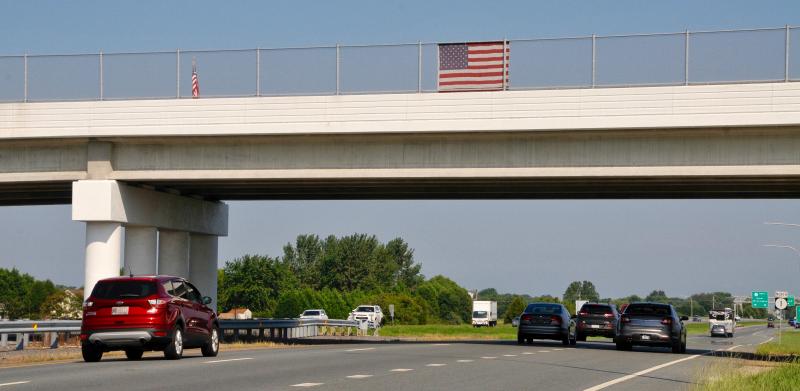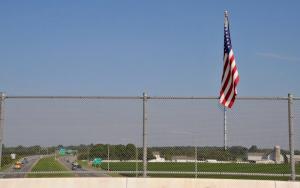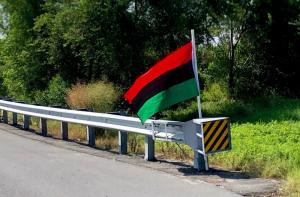The Nassau Bridge is not the only state-maintained bridge where flags have been flown.
American flags are attached to the protective fences on some of the Route 1 overpasses, including the Route 30 intersection south of Milford and one near Dover Air Force Base.
While several flags were removed from the Nassau Bridge near Lewes, the overpass flags will not be removed, said Delaware Department of Transportation spokesman C.R. McLeod.
He said the Nassau Bridge flags were not the same as those attached to the overpasses.
“The Nassau Bridge flags were a temporary display honoring a police officer and public servant who passed away unexpectedly, and was never intended to be permanent. Any further displays will be immediately removed. We’ll have no further comment on this,” McLeod said.
He said there is no formal approval for the overpass flags. “The department does not believe they pose a safety risk,” he said. “We have not received any complaints about their presence being a distraction on overpasses, as they have been present for many years and we have chosen to let them remain.”
The overpass flags were put into place by Milford businessman and veteran Eli Valenzuela. He put the first flag on Sept. 12, 2001, to honor those who died in the Sept. 11 terrorist attacks.
Flag issue started in early July
DelDOT rules prohibit placement of any unapproved sign or display in roadway medians or within 10 feet of the edge of the road.
On July 10, Dave Repass put up a single Thin Blue Line flag on the bridge following the sudden death of his friend, Delaware State Police Master Cpl. William Matt.
That flag was removed by a Wilmington woman who was charged July 13 with theft, criminal mischief and traffic charges. Repass then put up a second flag, which was also removed by another woman. He put a third flag up the day of Matt's funeral July 16.
Six more flags for a total of seven Thin Blue Line flags were eventually added and secured to the guardrail.
On Aug. 4, all flags remained. That day, a Pan-African flag was attached to the guardrail at the base of the north end of the bridge. The red, black and green flag is also known as the Black Liberation Flag and is recognized as a flag supporting the African-American community.
The Pan-African flag disappeared midday Aug. 6; McLeod said DelDOT staff did not remove the flag, but did remove the Thin Blue Line flags.
The owner of the Pan-African flag, Jason Moran of Lewes, reported it missing about 4 p.m. that day.
Lewes man puts up Pan-African flag
Moran placed the Pan-African flag on the bridge at 11:30 a.m., Aug. 4. “The flag is something I believe in, so I put it up to see if I would receive the same treatment,” he said. “I really didn't think it would stay there through the weekend,” he said. It was stolen two days later.
Moran said the flag issue was getting out of hand, and he was particularly upset that two women were charged with a crime when the flags were placed on the bridge illegally.
But he also said he knew as soon as he put up his flag, the others would be taken down. “I wanted to prove a point that you can't just do what you want. There should not be any flags put there,” he said. “The other flags had been up there for more than a month.”
Moran said a lot of people do not view the Thin Blue Line flag as a symbol of tribute. “It's not a memorial flag and was never intended to be. It's more of a marketing campaign. It's disrespectful to the U.S. flag and against the flag code,” he said.
“As long as it was perceived as a police memorial flag, it was OK because some people think the law does not apply to them. It's not OK to do this. You can't put a flag up on a bridge,” he said.
Moran's flag was stolen around 1 p.m., Aug. 6, the same day DelDOT staff removed the Thin Blue Line flags. He went to Delaware State Police Troop 4 to file a complaint.
Moran said he's also concerned about the flags flying on the Route 1 overpasses. “They are illegal as well. I was told that nobody has complained about them and if there is no victim there is no crime. Will I have to put another flag there?” he asked.
Illegal signs are also a concern
While flags are attracting most the attention, illegal signs placed in the state's right of way are a frequent problem. It's illegal to place any type of sign in a road clear zone, which includes the median and 10 feet from the edge of the pavement.
Confiscated signs are subject to a $25 fine and $15 recovery fee and are disposed of after 30 days, with the fine still in effect.
Political signs are permitted outside the clear zone only 30 days before an election and 30 days following an election. Primary candidate signs were permitted to be placed along roadways starting Aug. 6. McLeod said all candidates are made aware of the state's sign regulations.
Real estate and open house signs placed along Sussex roads on weekends have been a sore spot not only for the state but Sussex County officials as well. The signs are posted Friday nights and removed Sunday nights.
McLeod said many real estate signs are placed illegally. “However, it is not possible to police every roadway to collect these signs when put out for short durations unless we receive a specific complaint,” he said.
Sussex officials updated the county sign ordinance, but did not address what they term bandit signs and the proliferation of feather flags.
The thin blue line
The thin blue line is a phrase used by law enforcement to delineate separation between order and chaos. Use of the flag has become popular recently by some as a symbol to honor the sacrifice made by law enforcement officers.

























































